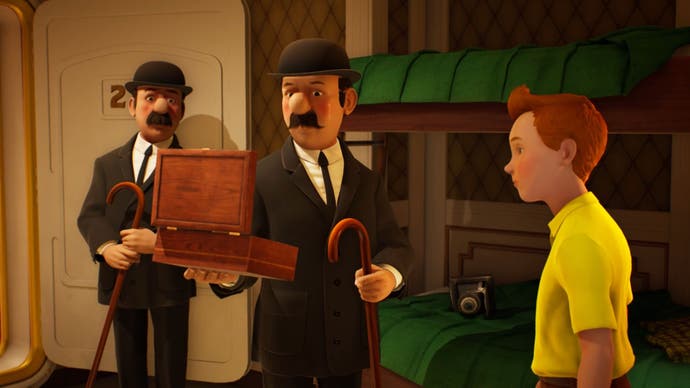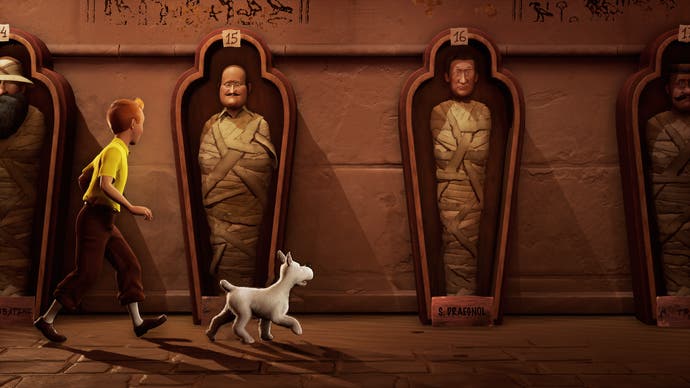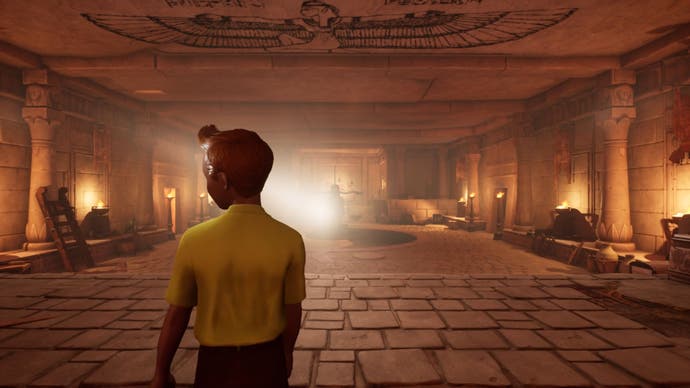Tintin Reporter: Cigars of the Pharaoh is an immersive dive into Hergé's world
Plane sailing.
When meeting a fellow Tintin fan, the first question you're likely to ask is simply: 'which one is your favourite?' Over the many years Hergé worked on Tintin, the cartoon went through several phases, ranging from the early comics where Hergé was still developing his style, to the later stories which had clearer plotlines and an established cast of supporting characters. My personal favourite? For me, it's The Secret of the Unicorn - a story with an intriguing mystery at its centre, and plenty of Captain Haddock action. It's perhaps unsurprising, then, that this was the comic selected for Steven Spielberg's 2011 film adaptation.
Given the vast catalogue of Tintin comics to choose from, some might ask why the upcoming Tintin video game adaptation is based on Cigars of the Pharaoh. As the fourth volume of Tintin published by Hergé, the comic is a relatively early one, and lacks key characters such as Captain Haddock and Professor Calculus. But for Spanish game developer Pendulo Studios and French publisher Microids, selecting the comic was a matter of considering what sort of gameplay opportunities the story could offer, while also leaving room for a potential sequel.
"As Microids and Pendulo started to work on a new Tintin IP, we wanted to start at the beginning," Microids brand manager Charles Leveugle tells me at a demo event. "But a complete beginning, not just the Soviets or America or Congo, a complete beginning with a complete adventure, with a variety of gameplay [styles], various countries to visit, various investigations to lead. In the first three albums Tintin is only living in one country… in Cigars of the Pharaoh he traverses three countries, he drives a plane, he drives a car, he meets Thompson and Thomson, he meets Rastapopoulos…
"Cigars of the Pharaoh was the perfect choice, and as it's [connected] with the Blue Lotus, it opens the door for the next game."
Before we start thinking about the next Tintin game, however, we should probably take a closer look at the game at hand. Releasing later this year, Tintin Reporter: Cigars of the Pharaoh is an action-adventure game, featuring a mixture of action sequences and puzzle-solving segments. A sensible combination of gameplay styles for a Tintin adaptation, really, given Tintin normally spends his time either investigating mysteries or narrowly escaping death. Leveugle tells me Pendulo Studios and Microids are aiming to make this adaptation "100 per cent faithful" to Hergé's original work. "The ultimate guideline of this game is the comics," Leveugle explains. "So we have a skeleton of the story, which we have to match 100 per cent, and then we can add some stuff in order to prolong the experience and make the game last around 10 hours."
So how do you extract hours of gameplay from just a few comic panels, while still remaining faithful to the original work? According to lead producer Rita Fortuny Pi, the key to this was making an effort to understand Hergé's workflow and overall way of thinking. The team looked to wider sources of inspiration to help fill in the gaps - including other comics and important historical moments from the time - along with the very first version of Cigars of the Pharaoh, published between 1932-1934. This had a much longer storyline that was later cut down, redrawn and coloured by Hergé to create the 1955 'second version' that is more well-known today.
"So our first inspiration was the last comic, the one with colours," Fortuny Pi explains. "But to expand some segments or add extra sequences, we had some ideas, and also some specific assets from the old comics to expand these segments. Not only from the original version of [Cigars of the Pharaoh], but also from other comics, and from other drawings that Hergé made, to make it last longer. We didn't want to construct anything from zero."

This approach is immediately noticeable in the very first section of the demo, where Tintin runs around a cruise ship to retrieve a piece of paper. In the comics, this moment only takes up a few panels; here it's extended to form a long action sequence, where Tintin must dodge various obstacles and people on the boat. It's perhaps a smidge too extended, if anything - there's something amusingly farcical about just how long Tintin runs around the boat chasing this pamphlet. The use of quick-time events to dodge obstacles isn't a new design approach, but the enjoyment here stems more from running through the world itself. There's constant action, noise, and amusing snippets of NPC dialogue to keep you entertained ("what's a papyrus?" yells one confused bystander). If you've ever watched the animated Tintin series from the 90s, you'll remember the series' enjoyably corny Italian-American mobster accents and exaggerated voice acting. Snippets of this can be heard throughout the chase scene, and it all adds to this sense of immersion in the world of Tintin.
Things are promising in the second section of the demo, too, where Tintin must investigate and puzzle his way through the tomb of Kih-Oskh. This is a slower-paced segment of the game, where you can really take your time to explore the environment. Again, the puzzle-solving gameplay here isn't too surprising, with Tintin interacting with items to discover clues and piece together the solution. The puzzle itself is well-balanced, providing a fair level of challenge without over-prompting the player or presenting something too obscure to understand. More importantly, it's just fun to poke around in Tintin's world during this scene. The main story and environments of the original comic are all still there, but they've been given further detail: a close examination of a painted frieze, for instance, reveals a sinister eyeball staring down on Tintin from a hole in the wall.

Many fans will wonder why this game was made in 3D, rather than using a 2D style similar to Hergé's original artwork. According to Leveugle, the choice of 3D was partly to distance the game from the style of the 90s Infogrames Tintin platformers, but it was also about creating a more immersive experience for the player. "Our main goal is to embark people on an adventure… so the 3D style is the perfect solution to that, because you have realistic environments, realistic behaviours, and you don't have to make the translation in your head between cel shading and what a realistic situation would look like," he says. Fortuny Pi mentions that this was also a matter of playing to Pendulo Studios' strengths, as the developer has previous experience of making games in 3D. Using a 3D art style also provided some much-needed separation from the original comics, allowing Pendulo Studios some creative freedom while avoiding direct comparisons to Hergé's signature ligne claire art style. "The only person who knows how to make Tintin in 2D is Hergé," she adds.
While the first two gameplay segments in the demo are quite charming, the third gameplay section - in which the player controls Tintin's plane as he's pursued by an enemy aircraft - is a little weaker. The controls here are quite simple, offering the ability to steer the plane and roll sideways to avoid obstacles. The player must navigate through floating 'ring' checkpoints, but when flying through rocky outcrops, it's sometimes hard to distinguish exactly where you're supposed to be going. If you do hit a rock, the plane simply explodes, and you are reset at an earlier checkpoint. It's a very strange feeling when this first happens, as one of the key elements of the comics is the many absurd ways Tintin avoids death, so to see him explode is quite jarring. From a game design perspective, however, the gameplay does need some form of fail state to create a sense of risk, so it's a difficult problem to solve. Perhaps we can all imagine that Tintin and Snowy miraculously parachute their way out of the plane?

Another topic I wanted to discuss with Leveugle and Fortuny Pi was whether they had encountered any difficulties adapting Tintin for the modern age. Hergé's work has rather famously faced criticism for containing racist stereotypes and imperialist attitudes, particularly in his earliest works such as Tintin in the Congo. Hergé himself later expressed regret for these depictions, explaining that he was influenced by paternalistic attitudes in Belgium at the time. But problematic elements can still be found even in his later works: so how did Microids and Pendulo Studios approach this difficult topic?
"Well, Tintinimaginatio is really aware of this subject, of course," says Leveugle. (That's the company responsible for protecting Hergé's legacy, by the way.) "This is why Tintin in the Congo, of course, is not canonical. As for the controversial themes in Cigars of the Pharaoh, we are lucky that they are not too controversial. You can place it within the time window [of when it was created]. Our goal is to make a game for everyone, and in this way it's a constant work. "
Fortuny Pi adds that they had to be picky on a couple of smaller details. "Because we want to make our game for the year 2023, we need to learn a lot from our past, [both] personally and for every country," she says. "So it was very easy to spot [these little moments], just rephrasing things, to be respectful to everybody." Often, these changes were only needed for secondary characters, which meant they could be easily reworked without having an impact on the main story.

It's clear that there's a huge amount of love for Tintin on the development team, with a great deal of attention paid to ensuring that the spirit of Hergé's work is at the heart of this adaptation. This enthusiasm comes across in the demo, which feels like entering a living, breathing world of Tintin. Is there enough here to appeal to newcomers to the world of Tintin? Of that, I am not sure: the gameplay here isn't anything radically new, and I sometimes wonder just how popular Tintin is with today's younger audiences. But for existing Tintin fans, there's something very enjoyable about simply pottering around in Hergé's world, as if you'd fallen straight into a comic book. Or in the words of Thompson and Thomson - to be precise: we're falling for this game.


